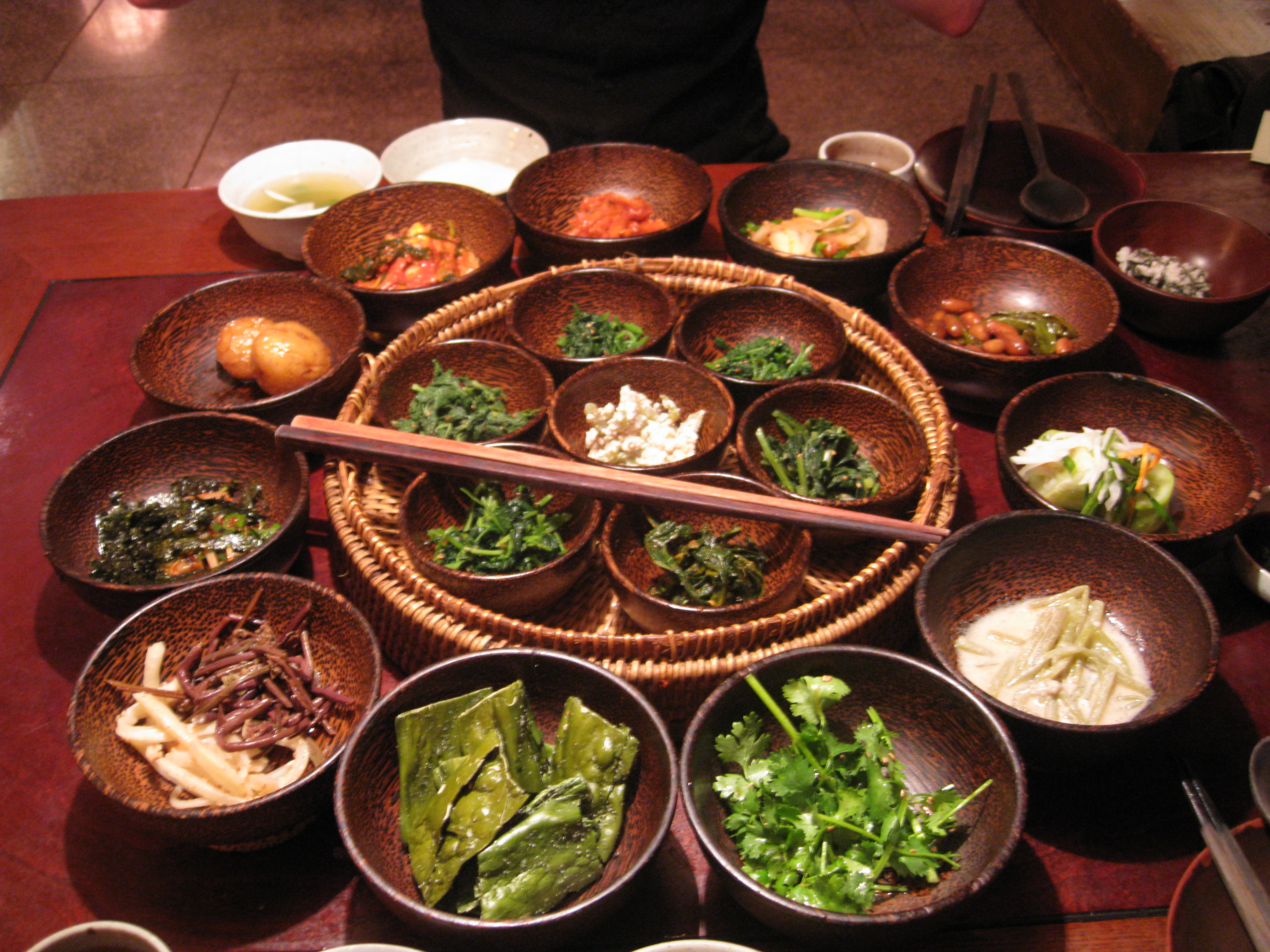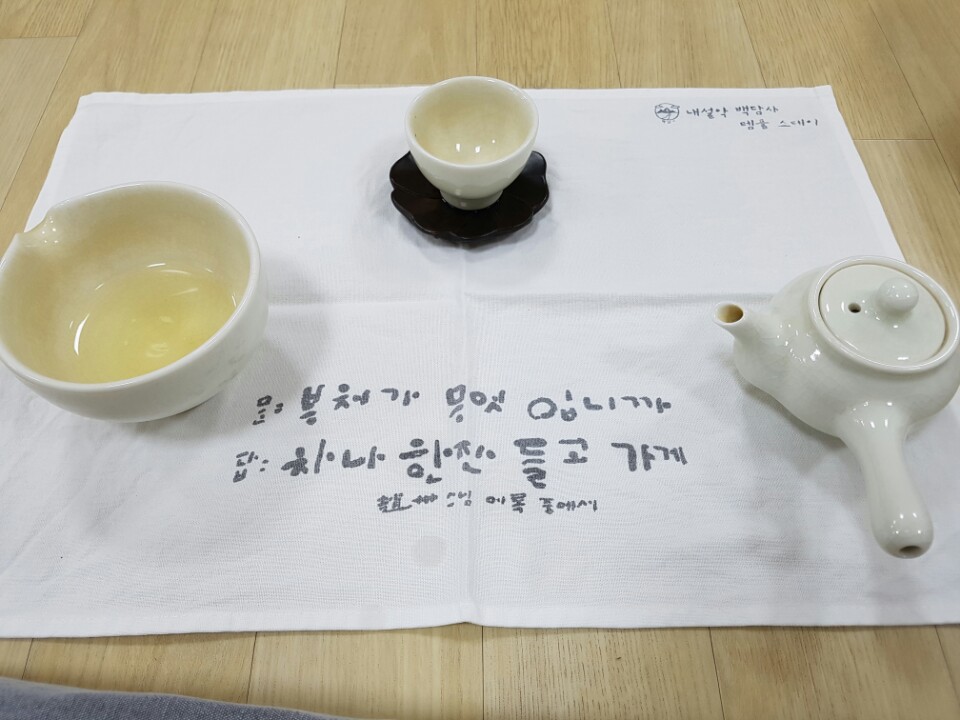
Tea meditation teach-in by Nun Baekgeo
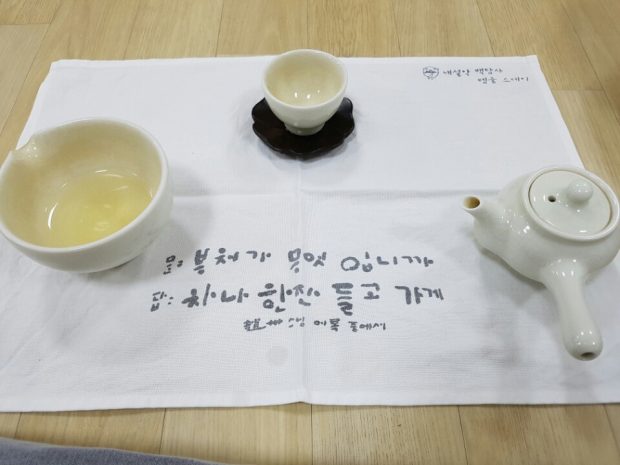 Seated with our legs crossed in lotus posture, we made an effort to relax on cushions placed on the timber floor, warmed by steam pipes underneath.
Seated with our legs crossed in lotus posture, we made an effort to relax on cushions placed on the timber floor, warmed by steam pipes underneath.
Coming in from the chill outside the large temple hall, the balmy atmosphere was more than welcomed. If anyone of us had expected a chanting of mantra, to induce a meditative mood, there was none.
Baekgeo made it simple for us neophytes: Swallow your breathe deeply and blow it out, the rhythm calms your mind. Relax.
Clad in a light grey nun’s habit and cape, she spoke using a pocket-size speaker. Make yourself comfortable, she added, seeing our mixed bunch of Buddhists, Christians and Muslims, shifting about in various free-style poses on the floor-mattress.
Following a day of meeting, sight-seeing and bus journey, we were glad to sit at the feet of a meditation guru. “If you forget about trivial things, then you don’t know the importance of life,” Baekgeo said, “If I am a bus driver, I can transport you; if a restaurant owner serve your food. Because I am in the Buddhist temple, I can serve you tea.” It was karma, a Buddhist concept, that she and we, coming from far-away such as Uzbekistan, Kazakhstan, Kyrgyzstan and Georgia, were meeting together. Baekgeo must have been touched and grateful, offering a thought for the occasion: ”Everything can be anything. Even over a cup of tea we can think about life and how happy we can be together.” Reinforcing it with “Happy people make better tea. It’s mind over matter.” The setting mattered too. The pure white ceramic tea pot and two cups — a pint-sized one with some green tea leaves and a bigger empty one — are laid out on the tea towel in a triangular formation. Presumably, for ease of movement within the points of the triangle.
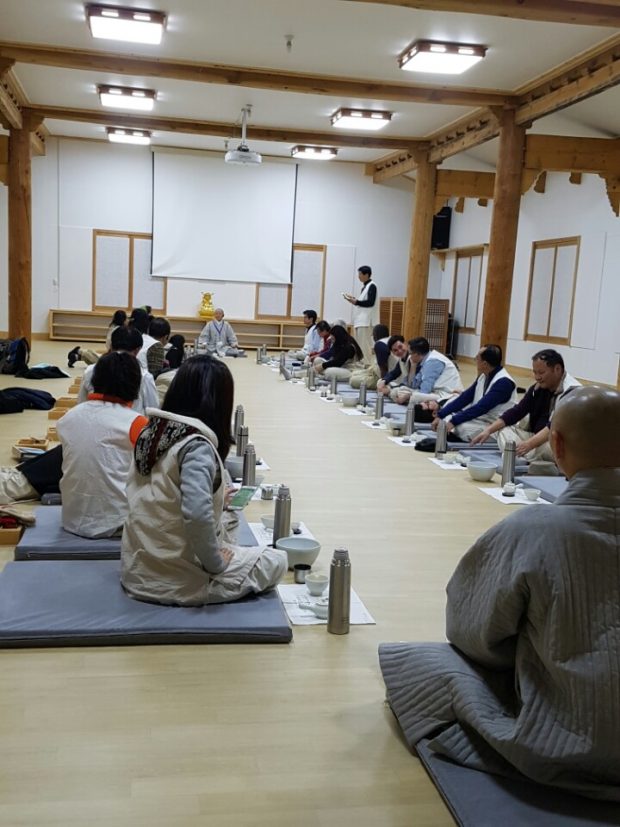 A themos flask of hot water stands outside the triangle. Ready? Lets make tea! Not so fast. Here pick up a tea leaf and smell it, said Baekgeo. Bite and taste it. Crunchy with a distinctive flavour. A special fermented tea.
A themos flask of hot water stands outside the triangle. Ready? Lets make tea! Not so fast. Here pick up a tea leaf and smell it, said Baekgeo. Bite and taste it. Crunchy with a distinctive flavour. A special fermented tea.
Next, pour out the water from the flask into the big cup, two-third’s full. “Did you hear the happy sound of gurgling water like a rushing brook?” Baekgeo asked. Seeing Nature in a tea-cup is for steady hands and merry hearts! Then for the command we had been eagerly awaiting: empty your tea leaves into the teapot and pour fresh hot water into it. All at once, a flurry of hands targeted streams of warm water gently down upon dried slivers of tea. As the water swirled around the leaves, a light amber liquid emerged.
Now lift up your tea-pot, taking care to place your thumb on the cover, the index finger at the edge and three other fingers at the base, and pour the brew into your drinking cup. Here comes the heart of tea meditation: Savour the moment.
I was thinking of taking a sip when Baekgeo said: Bring your cup close to your lips, and let your lips gently touch and feel the texture of the tea.
Yes, go on and roll it around with your tongue. Wow, such a sensual experience. For me, drinking tea would never be the same again. Enjoy your tea, said Baekgeo and I awoke from my revelry. I looked up, in time to catch a glimpse of an amused Anucha Charoenpo, news editor of the Bangkok Post, throwing knowing glances at fellow meditators, as if to say “writing against deadlines we don’t have the luxury to chew cud”. (He was to attract the attention of Baekgeo during dinner for clearing his plate before the sand-dial on the table hit the halfway mark!)
Yet, don’t we have our contemplative persona in the newsroom? The guy hunched over his computer, sipping his cuppa and pondering the right word or turn of phrase. And don’t we also see a parallel between the art of meditation and communication in the technique and skill Guru Baekgeo displayed in taking us, step by step, through the teamaking? Indeed, the state of greater personal awareness underlying meditation has inspired the rise of Mindful Journalism research in the West and Asia as an alternative to Fourth Estate or libertarian journalism.
Characteristically, the Mindful Journalism model draws its ethics and perspectives rom Gautama Buddha’s Vippassana Meditation teachings 2,500 years ago. Among other things, a mindful journalist is not one who goes for scoops come what may. Rather, he will reflect and deliberate, especially on the potential impact of his writings on society.
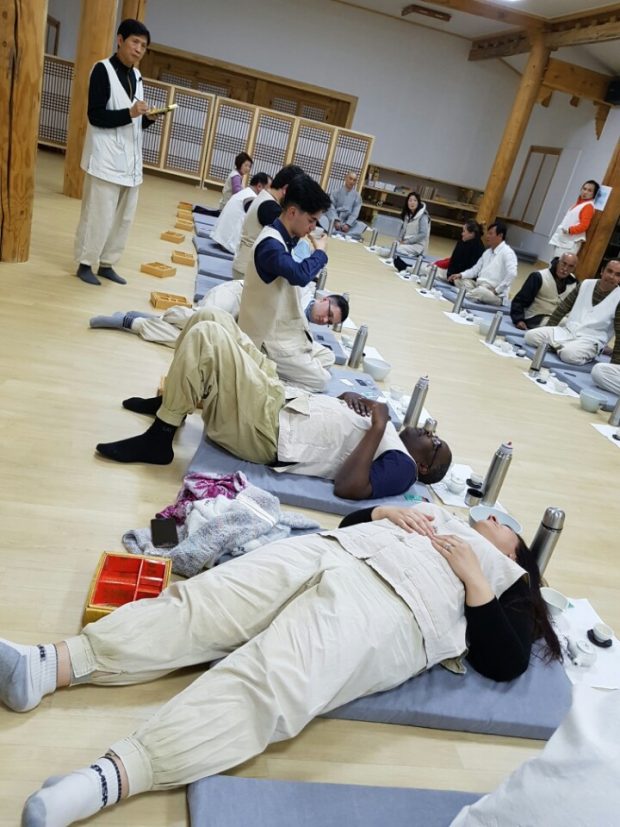 He or she hews to the Buddha’s Eight-fold Path virtues, such as understanding that is free from superstition, honesty, truthfulness, and altruism. Western communication professors see in mindful journalism the ethical counterpoise to the “Published and Be Damned” journalism that is underpinned by liberal traditions of John Stuart Mills and Thomas Jefferson. The scholars voiced concerns over the excesses associated with the libertarian Press, including sensationalism, plagiarism, and gossip journalism.
He or she hews to the Buddha’s Eight-fold Path virtues, such as understanding that is free from superstition, honesty, truthfulness, and altruism. Western communication professors see in mindful journalism the ethical counterpoise to the “Published and Be Damned” journalism that is underpinned by liberal traditions of John Stuart Mills and Thomas Jefferson. The scholars voiced concerns over the excesses associated with the libertarian Press, including sensationalism, plagiarism, and gossip journalism.
Add to this is the current menace of fake news. In the Internet age and globalised world, they are also looking for a more universal code of conduct for professional journalists and bloggers. For Asian communication academics, mindful journalism has raised the profile of Oriental philosophies, from Buddhism to Hinduism and Confucianism, and their input and impact on mass media. They have spawned the Development Communication model favoured by developing nations in the region.
Rounding off the evening’s meditation activity, Baekgeo led us on a circum-ambulation ceremony outside the dimly-lit temple grounds. With light from a lotus-shaped candle encased in glass we each held in our hands, the procession paced along centipede-like, as she tapped time. We were doing walking meditation.
“Think happy thoughts,” her voice piercing the chilly air. “Happy are those who shed light,” seemed a fitting thought.



